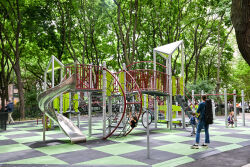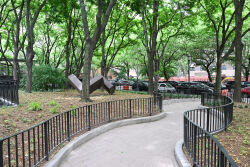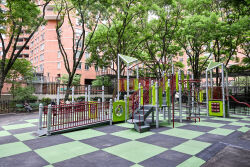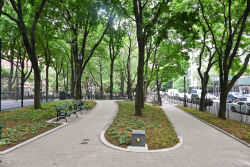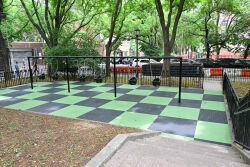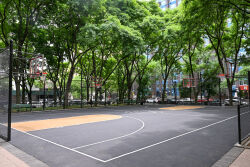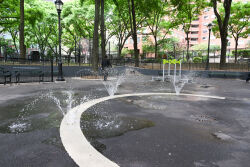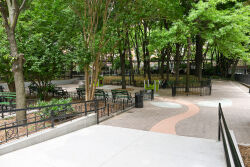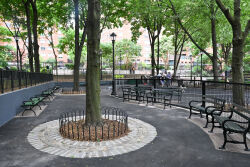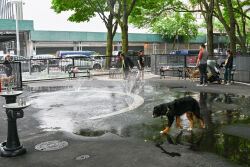Bellevue South Park
Bellevue South Park
What was here before?
This parkland fell within the Bellevue Urban Renewal Area that included Kips Bay Plaza on East 30th Street. The urban renewal project began in 1959, and dramatically changed the face of Manhattan’s East Side from East 23rd to East 30th Streets between First and Second Avenues. This was controversial among area residents, some of whom desired rehabilitation of older structures, rather than complete razing and rebuilding. Ultimately, tenements and old factory buildings gave way to a new, transformed community centered on a complex of eight mixed-income apartment buildings known as Phipps Plaza.
How did this site become a park?
Bellevue South Park was mapped in 1966, a welcome green space for the increasingly residential neighborhood but was undeveloped for several years, a victim of the city’s fiscal crisis in the mid-1970s. In the late 1970s, the city agreed to pay for the construction of the park after Community Board Six and residents of the neighborhood promised to cover the expenses needed for its maintenance. The park opened in November 1979, and the Better Bellevue Association maintained it for the next seven years. The Association, a coalition of residents and nearby institutions including the Phipps Plaza Community Center, the Parks Council, the New York City Environmental Fund, and Community Board Six, organized senior activities, lunchtime concerts, and children’s programs.
The city took control of the park after the worst of the fiscal crisis had passed, and Parks assumed jurisdiction over Bellevue South Park in 1986. A park renovation in 1997 transformed the park into its current layout. The concrete wall surrounding the park was removed and trees and planting beds replaced what had been concrete and asphalt in the interior. Playgrounds to the north and south were installed, each surrounded by a dense tree grove. A basketball court was placed in the south precinct. A children’s spray shower in the north end includes decorative bronze details of foliage, turtles, frogs, and cherub heads. The north playground also features cast concrete frogs and a decorative fence featuring rabbits, turtles, and chicks.
Later a dog run was installed adjacent to the central pedestrian corridor and seating area, and in 2001 Antoni Milkowski’s abstract sculpture entitled Skaggerak was relocated from Madison Square Park to this park’s northern landscape. A renovation in 2023 replaced the south playground with a greatly enlarged ADA accessible dog run, reconstructed the basketball court and north playground, and updated the central planting beds and added additional play units for small children in the spray shower precinct.
What is this park named for?
The park takes its name from nearby Bellevue Hospital, one of the world’s leading medical institutions for more than two centuries. The original hospital opened as an almshouse in 1736 on the lot now occupied by City Hall. In 1811, New York City purchased Belle Vue farms on the scenic promontory located at East 27th Street and 1st Avenue. The land became the Bellevue Institution, in effect, a community center with an almshouse, a pesthouse, a soap factory, a greenhouse, a penitentiary, a school, a morgue, a bakehouse, an icehouse, and a shop for carpenters and blacksmiths. The institution was dedicated in its entirety in 1816.
Though associated in the popular imagination with madness and mayhem, this hospital has been the scene of many medical innovations and breakthroughs in public health. It has also been on the frontlines of several epidemics — yellow fever in the 1700s, cholera in the 1800s, AIDS in the 1980s, and more recently the Ebola outbreak of 2014, and the Coronavirus (COVID 19) pandemic commencing in 2020. Today, the public hospital is affiliated with the New York University School of Medicine
Check out your park's Vital Signs
Clean & Safe
Green & Resilient
Empowered & Engaged Users
Share your feedback or learn more about how this park is part of a
Vital Park System

